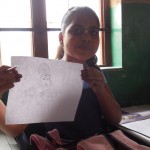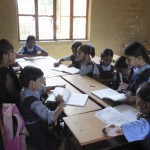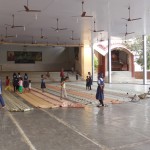Jay Laxman (everyone’s favourite Sanskrit teacher) decided to share his love for language with Vrindavan’s most deserving girls.
Interview by Matthew Whitlock | Photos by Jay Laxman
Tell me about your trip to India and why you wanted to go?
I‘m doing my PGCE at university and there was an opportunity to do an alternative placement choosing either an EAL score, SEN, a PRU or somewhere abroad. As soon as I heard that I thought “Ooh! I’ll go abroad!” I love the idea of travelling and when they gave us the dates for October, I thought “that must be Kartik Maas” (considered in India as the holiest month) and I straight away thought of Vrindavan. I hadn’t been for 4 years and really missed being there. The first school to pop into my head was Sandipani Muni School. I’d visited 8 years ago and thought it would be a great opportunity, knowing that it gave a free education to poverty stricken girls. Girls in India can get a rough deal sometimes, so as a feminist, I thought “perfect”.
How might they get a rough deal?
They can be treated as second-class citizens, married off as early as 12, 13, 14. That’s the age groups I teach here at Avanti House! It was amazing to see the things they do for girls: a charity-run school providing a free education, medical help, uniform, meals – a chance to explore the world which is outside their small house and village.
Have you seen for yourself how hard a child’s life can be?
You see little children playing in the dirt, or being made to clean the streets, doing very hard, menial jobs and I think “Huh? This is during the day – surely you’re supposed to be in school? (in India, the school week is Monday to Saturday) If you’re out during the week in this country, you wouldn’t see children.
Are these children that would want to be in school if they had the chance?
Definitely! At Sandipani Muni School, you can see it on their faces. They’re so happy and content, although you can tell they have so many problems at home. They arrive unwashed, messy hair, but they’re so happy to be there. Kids in this country spend ages doing their hair and looking good but are miserable, “I can’t wait till 3.30 so I can out of here!” It’s so different to the attitudes out there.
They’re not taking the opportunity for granted out there…
Not at all.
So were you scoring points while out there?
Haha! Yes, it was part of my PGCE which I’m doing part-time. When I told the course leaders I’m going to India they thought it was amazing. The whole university heard about this and wanted to know more. They already do a trip to Sanga (in South India) and now want to liaise with Sandipani Muni School too.
What was your itinerary like?
It was for 2½ weeks. School starts at 8.30 and finishes at about 3 o’clock. I was supposed to observe lessons but as soon as they found out I was a Sanskrit teacher and teach at the Avanti schools, they were “Ooh! We’re gonna have you teaching!!” So during the day I taught Sanskrit to all the different year groups – mostly all primary and KS3, and that was interesting, teaching them grammar, as they already know the script (it’s the same as Hindi). After school I’d go back to my hotel, shower, get changed, so that at 4 o’clock I could start my seva, making flower garlands for the Radha Raman temple.
[quote style=”boxed” float=”right”]”Sanskrit is taught everyday! I was like “Woohoo, everyday – I love it!”[/quote]
I then deliver them to the temple, on the other side of Vrindavan, and then I’m there until the last darshan (service) at 9.45, where they play the flute while they put the deity to rest for the night, so I’d stay right till the end of the temple day. Then take a rikshaw home to sleep for 10, and up the next day and do the whole thing again. Inbetween all of that, I’d have to plan lessons as well, so it was busy busy! I did have a break for five days during Kartik and Diwali, and spent a lot of time at the Radha Raman temple, so that was nice.
Had the girls ever been taught Sanskrit at the school?
Yes, yes, It’s taught everyday! I was like “Woohoo, Sanskrit everyday – I love it!” The only sad thing was that the Sanskrit teachers were actually Art teachers or English teachers and know some Sanskrit but because they were all Hindi speakers, they know the script but the pronunciation was all Hindi. There were times when I had to say “er, that’s not how you say it” or “there’s errors in your grammar” and at one point they felt a bit intimidated by me, so I went quiet. I didn’t want to do that to them, to make them feel that their lessons were inadequate. So when I got to teach, I concentrated on grammar, sentence formation – it was great.
Their mother tongue is Hindi, which gives them an advantage. They know the Devanagari script, so straight away they can read, but it was whether or not they understood the sentence, so I was teaching pro-nouns and subjects, the nominative and the verb, the object, how you fit it all together.
How do you feel they compared to children of the same age in this country?
Considering the fact that they might have started their education late, their learning might not be encouraged at home, the school itself might be under resourced? I think because they’re so well behaved and have an amazing respect for their teachers, I think that comes to play, because spending time managing behaviour reduces teaching time. So I think out there, they’re really with it. As soon as I’d arrive, I’m straight onto the board, teaching them grammar. They’re actually well ahead! They read passages from Mahabharata, Ramayana and they understand. Here I have to start first with the Devanagari script and eventually move on to grammar.
In the afternoon I taught English phonics to a group of six. We went over certain vocabulary words like “What’s the meaning of tip, top and tap? They sound similar, but what are the differences? Translate them but use them in a sentence.” I found that when they were given sentences, they would regurgitate it through memory. So I’d have to challenge them, “Now give me the word in a different sentence” but they couldn’t. In many projects, they were only repeating what they had been told, just to pass an exam, and that, I don’t like.
That’s a very old-fashioned approach…
I know, so I would challenge them, using examples around them, like “look at the ‘top’ of that temple outside” or “what else is on top of the table?” rather than the same things they are memorising.
You went there to observe – it sounds like they were getting the most out of you!
Did they end up observing you? There was a point during their classes that they would ask me, for example, “how would you assess that?” They don’t have Assessment for Learning out there, but still, I didn’t want to tread on toes.
I imagine for UK students, studying Sanskrit will also deepen their understanding of the structure and origins of other languages, but in India, is there a special significance?
Primarily I think it will be a devotional one – a spiritual one. It allows them to access all of their scriptures: the Bhagavad Gita, which is a part of the Mahabharata, the Ramayan, other epics, and if they go on to do Vedic Sanskrit, then the Vedas. And there is SO MUCH literature depending on what school (of philosophy) you come from. It’s natural out there, that “Oh, I’m a Gaudiya Vaishnava” or “I’m a Sri Vaishnava” or a Shaivite, or follower of Durga. They all have scriptures from within their own school.
It sounds that while Hinduism is so diverse, the Sanskrit language acts as a thread that runs throughout the various sects – more evidence of its relevancy as a language subject.
And it’s not just Hinduism. Sanskrit is also used in Jainism and Buddhism.
How would you describe the typical life of a girl that goes to the school, born into a poor family, in a traditional village in Uttar Pradesh?
Many girls do alot of chores and housework; cooking and cleaning from a young age, being trained as a perfect housewife, serving her in-laws and husband. Her life will centre around the house, maybe going out to the market or helping her parents with what ever job they have, so pretty much working all day. They will most likely be married off at the age of 12 or 14 – very young – and once they’re married, they’re under the orders of the in-laws. It’s quite sad. In the UK, you never see anything like that.
For those girls, they might not know anything else, surrounded by people living a very similar life. Do they ever question their life? Are they happy to be doing what they’re doing? I don’t think they question because they’re not exposed to anything else. Some don’t have TV or media to make them think “Oh, life could be this way instead”. They only see life in their household and – their mother did the same, her grandmother did the same – they think of it as normal.
[quote style=”boxed” float=”right”]”Girls from villages will most likely be married off at 12 or 14. Then they’re under the orders of the in-laws”[/quote]
Do some parents resent their child having broader horizons?
No, not at all. Many go on to study in colleges, like in Mathura (the nearest city to Vrindavan) and then go on to start a professional career, which is great! I remember one day, I was at the Radha Raman temple and saw a girl I’d taught on the street, and wondered why she wasn’t in school. So the next day I asked her teacher and they said that sometimes, if parents need them to do something, or run errands, they take them out of school.
So parents are quite casual when it comes to attendance?
It seems so, but the school is trying to adopt the western approach of “no, your child must come to school everyday, Monday to Saturday, no matter what”. But it’s a voluntary school, so it’s difficult.
So in terms of the law in India…
Law? Is there one?! [laughing!] Actually, they do have rules on attendance, but whether it’s followed is another thing!
You already felt strongly about equal opportunities, so I suppose this trip complimented your personal beliefs?
Absolutely, I’m a real feminist. It was funny – on the flight back, I was watching a Hindi film about women that had been badly treated by husbands, helping them through education, like teaching them to read. It was so inspiring! And then I thought “this is alot like what I’ve been doing” – encouraging women to stand up for their rights, that they shouldn’t have to put up with being hit or treated like a domestic slave. So when I got back I went straight to the Trust and spoke with Nitesh, “Let’s do something!” Here in the UK, we’re all trained teachers, we have 14 weeks off in a year – surely there’s a way we can give something back to a school like this? The trip really affected me, so I think “come on, we can do it!”
The beauty of your idea [of taking teachers to the school in India] is that there’s lots to be gained on both sides. You went out there to observe, but it transformed into something much more. How do you think a trip like this would benefit Avanti teachers?
It was humbling. The classroom walls – they’re horrible. They have no resources. There’s no interactive whiteboard, just an old blackboard. There’s no photocopier. How do you teach when your resources are so limited? That was amazing, to be given a piece of chalk and told “go on, teach”. You’re thinking, “I need my white board! What about my PowerPoint?!” but you adjust. So now I’m back, if my laptop or whiteboard isn’t working I think, “right – the lesson must go on” and I just figure out how to make it happen. It gave me a new set of skills.
Another benefit is for those that want to learn more about Gaudiya Vaishnavism, Chaitanya Mahaprabhu and Krishna. The Sandipani Muni School is trying to educate children alongside teaching this philosophy, so in many ways, our objectives are the same. They learn quotes from the Bhagavad Gita, they read the epics like Mahabharata, and all sorts of Vaishnava books. It would be great for our colleagues to see that out there.
Also, Vrindavan is the place where Krishna had pastimes. The stories become real, “this is where Krishna danced with Radharani, this is where Krishna played in the Yamuna river”. Teachers often tell me they’d like to go and see these places for themselves. I think it would be a wonderful experience. I’m a Vaishnava Hindu myself, so for teachers that aren’t of the faith, it’ll be a similar experience to when I go to Athens and I see the Acropolis, where they did the sacrifices for Athena, or to Delphi, where they heard the Prophecies of Apollo from the Pythia.
How would you structure a trip? It sounds like you’d be the obvious choice for group leader and tour guide!
Well, visiting Mayapur was also considered, because that’s where you’d learn all about Chaitanya Mahaprabhu, but what I like more about the Sandipani Muni School, is that while they’re a faith-based school, they’re also very independent and not connected with any particular institution there. There’s also a lot of westerners involved in the running of the school, from places like America, Australia, Italy, so it’s very convenient for our groups. There’s a coordinator who allocates different classes to volunteers, depending on what subject you teach. They also have their own accommodation near the complex which was stunning! It was clean, near to shops – it was great.
The nearby ISKCON temple has an information centre and tour guides that take groups to see all the important places nearby. There’s a lot to be learned from going out on these day trips. At school, we celebrate festivals like Govardhan Puja, so when the teachers come back, they can say “You know that mountain that Krishna lifted up? It’s not a small mound like you see in the paintings – it’s a BIG HILL, because we tried to walk around it and it took 4 hours!” So it’s likely we’ll be booking rikshaws, because I can’t see everyone wanting to walk, do you know what I mean? (laughter!) There are some beautiful temples out there, even deities that miraculously manifested on their own, like at the Radha Raman temple. Many of these temples have a real significance to the history of Gaudiya Vaishnavism. And there are some great restaurants too, that are popular with westerners.
How long might the trip last?
I think 10 days would be plenty. That would mean 6 days teaching, with weekend either side, giving you time to take a look around and see the area. When most people think of India they think Taj Mahal, and Agra is only an hour from Vrindavan, so I can imagine everyone saying “Let’s go!” They get to tick off one of the seven wonders of the world! Another thing that makes the trip is that Vrindavan is also a very typical Indian place. You will see monkeys stealing fruit from the markets, cows in the middle of the road – and what do you have to do? You have to go AROUND the cow – that’s normal! The traffic, going in all directions, people calling out from shops for you to come buy things, the smells of all the different street food cooking away; Vrindavan definitely gives you the full flavour of life in India!
You miss it don’t you!
Don’t worry – I’m going back in 3 weeks!

























